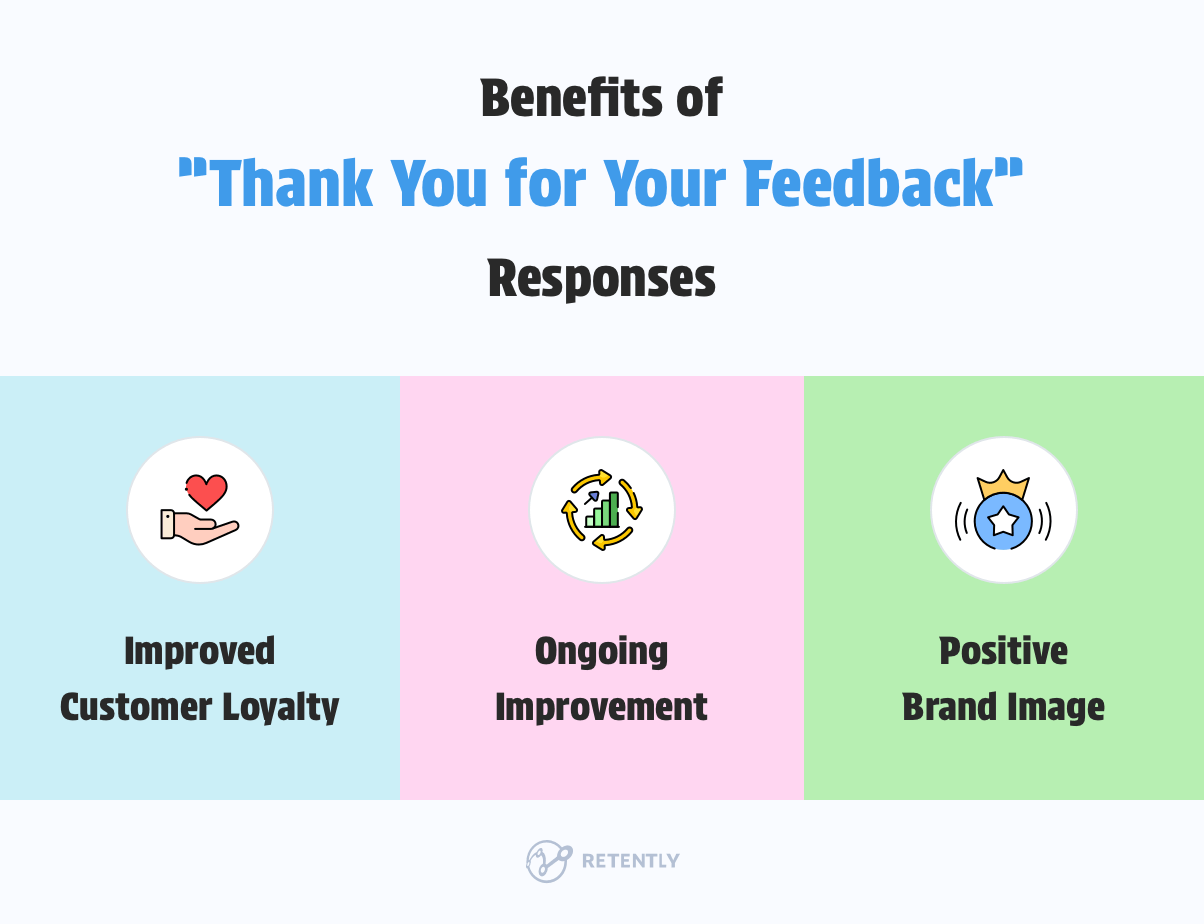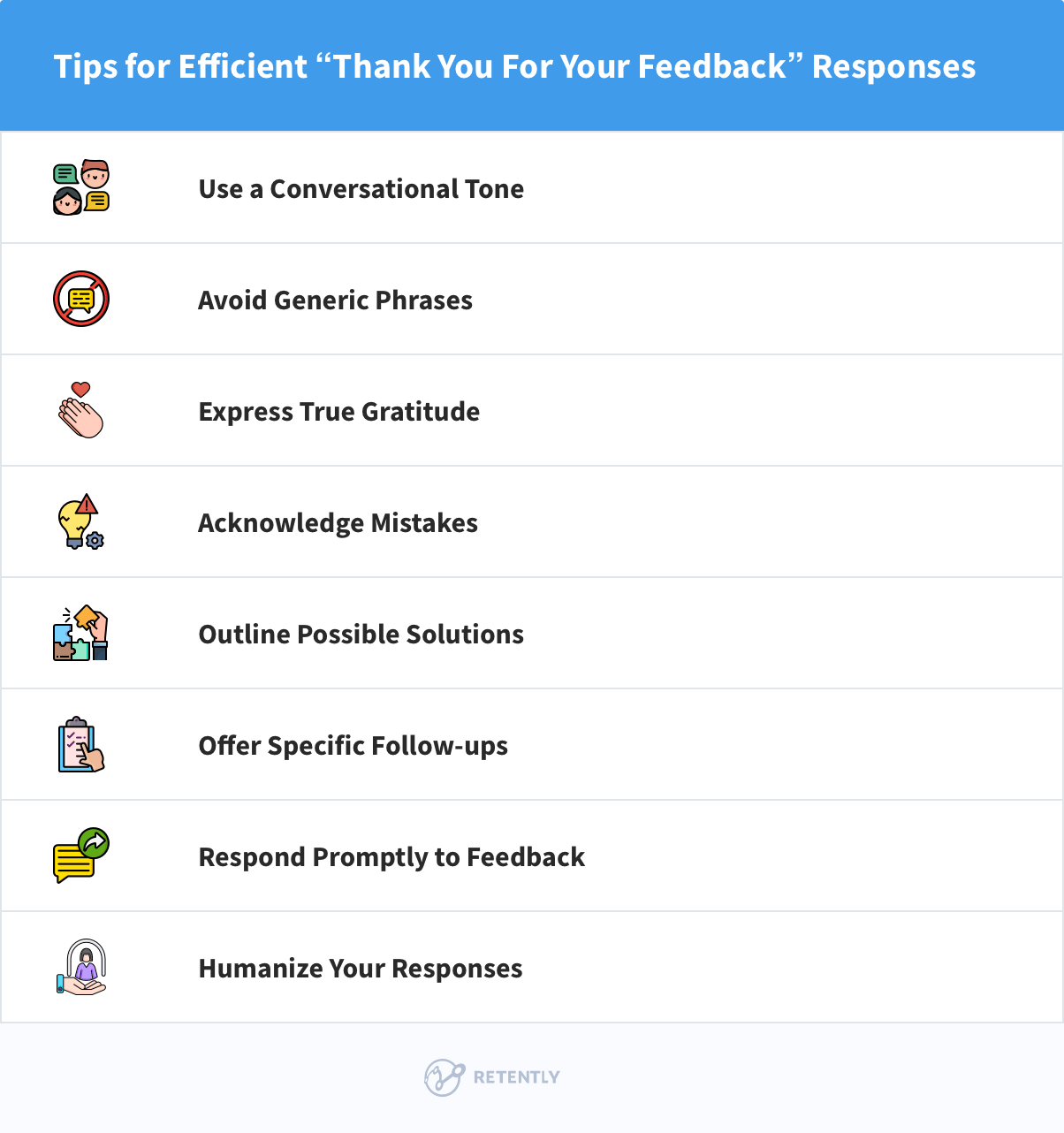Acknowledging your customers with a “Thank you for your feedback” is more than good manners; it’s crucial for building lasting relationships. But how do you respond in a way that’s both genuine and impactful? Whether you receive enthusiastic praise or face critical remarks, we’ll give you relevant examples and know-how to make your every response count.
This article will also explore 25 ways to say “Thank you for your feedback”, each designed to improve customer relations and foster a positive business image. From crafting personalized responses to using feedback as a motivation for improvement, this guide will equip you with the tools to acknowledge your customers’ input and use it as a launchpad for growth.
Key Takeaways
- Expressing gratitude for both positive and negative customer feedback is essential for maintaining strong customer relationships and reflects a brand’s commitment to customer satisfaction and service improvement.
- Personalizing responses to customer feedback by using the customer’s name, addressing specific details, and maintaining a professional and approachable tone improves the authenticity of the interaction and makes customers feel valued and heard.
- Efficiency in handling customer feedback can be achieved through a library of tailored response templates, automation, and an understanding of the importance of quick response times to foster customer loyalty and trust.
- By acknowledging and valuing customer input, businesses can cultivate a culture of appreciation that resonates both internally and externally, leading to enhanced customer satisfaction and loyalty.
Mastering Gratitude: “Thank You for Your Feedback”
Believe it or not, two simple words – “Thank you” – can work wonders in the business world, especially when responding to customer feedback. Acknowledging a customer’s effort to share their thoughts or experiences validates their input and strengthens their connection to your brand. It sends a clear message: you value their opinion, and their voice is heard. This small act can transform a casual customer into a loyal advocate, amplifying the positive perception of your business.
When you express gratitude towards your customers, it triggers a positive psychological response. When people feel appreciated, they experience a sense of belonging. This feeling fosters a deeper emotional connection between the customer and the brand. Customers who feel valued are likelier to repeat business, share their positive experiences with others, and even become more forgiving of minor inconveniences or mistakes.
Yet, creating a culture of gratitude isn’t just about external interactions; it starts within your company. Encouraging employees to express appreciation and acknowledge each other’s contributions creates a more positive and supportive work environment. This internal culture reflects externally in how your team interacts with customers.
Employees who feel appreciated tend to express gratitude and positivity in customer interactions, boosting the overall customer experience. By embedding gratitude into your company’s DNA, you ensure that “Thank you for your feedback” is not just a phrase but a reflection of your brand’s values and approach to business.
Crafting Perfect “Thank You for Your Feedback” Responses
Hence, the core of engaging with customer feedback is not simply to hear what they have to say but also to show appreciation. Whether it’s a compliment or complaint, expressing thanks for such feedback shows your brand’s dedication to customer happiness. Learning to respond effectively to each can significantly strengthen your relationship with them.
Taking the time to craft personalized replies that express gratitude for their input can transform a routine exchange into an exceptional encounter. For example, when you thank a customer for complimenting your quick service and reiterate your commitment to efficiency, it reinforces their positive experience. This acknowledgment can encourage them to leave more favorable feedback in future interactions.
Tailored email templates for feedback can streamline these communications without sacrificing the personal touch that makes recipients feel valued. It’s not just about the content of these emails but how they reflect your commitment to outstanding customer service, showing that you prioritize excellence in every interaction.
Crafting responses that take into account the voice of the customer requires a thoughtful approach. Using our tips as a roadmap, you can fine-tune your interactions to ensure they’re effective and resonate well with your clients.
Responding to Positive Reviews with Grace
Crafting responses to positive reviews is a skill. It requires a delicate balance of expressing gratitude and fostering continued engagement. Here are some tips for drafting personalized and effective responses to positive reviews:
- Personalize your response by using the customer’s name. For instance, a simple “Thank you, [Customer’s Name], for your positive feedback!” can go a long way in promoting a positive customer experience.
- Express gratitude for the customer’s feedback and let them know that their opinion is valued. This shows appreciation and reinforces the positive behavior of giving feedback.
- Acknowledge specific aspects of the feedback to show you’ve paid attention and encourage the customer to continue the dialogue. You might say, “We’re so pleased you enjoyed [specific aspect]! Your feedback is incredibly helpful, and we’d love to hear from you anytime.”
- Include a call-to-action in your response, like asking for a testimonial or encouraging repeat business. It can foster engagement and help build a loyal customer base.
While showing genuine excitement for the positive review is important, a short and impactful response can hold the reviewer’s interest.
Handling Negative Feedback with Care
Dealing with negative feedback can be challenging, but it’s a golden opportunity for growth. The key is to maintain a professional approach. Here are some tips for handling negative feedback and even turning a negative experience into a positive one:
- Accept criticism without acting defensively.
- Acknowledge the issue and show empathy.
- Seek clarification to understand the customer’s concerns fully.
- Offer solutions to address the customer’s issues.
Avoid defensiveness at all costs, as it can escalate the situation and harm lasting customer relationships. Instead, use negative feedback to improve your services and boost customer satisfaction.
Recognize their dissatisfaction and express regret that their experience did not meet expectations. This shows that you take feedback seriously and are committed to improving.
Navigating Mixed Feedback: The Balanced Approach
It’s important to strike a delicate balance when receiving feedback that includes both endorsement and criticism. Make sure to recognize the honest feedback the customer provides and convey appreciation for their insights. An effective approach is the “sandwich method”, where you start and end with positive comments, enclosing constructive criticism in between. This technique helps maintain a positive tone and shows that you value all types of feedback.
Keeping your responses brief, around 100 to 150 words, ensures clarity and holds the reader’s attention. Pointing out their positive rating while addressing concerns offers a comprehensive perspective of their experience. Integrating kind words throughout your reply can also foster a positive dialogue, enhancing the overall tone of your response.
Personalizing Your Gratitude
Although we’ve slightly touched upon the subject, the importance of personalization is never overstated. Each piece of feedback is unique, and your responses should be too. Tailoring your responses to the specific type of feedback shows that you are listening and genuinely care about your customers’ opinions and experiences. For positive feedback, focus on reinforcing the positivity and gratitude. For negative feedback, emphasize empathy, understanding, and a commitment to improvement. Constructive feedback should be met with appreciation for the details and clearly indicate how you plan to use the insights provided.
Expressing gratitude in a personal manner extends well beyond the simple phrase “Thank You for Your Feedback”. It’s about recognizing the distinctive experiences of each customer and sincerely conveying appreciation for their insights. By including the customer’s first name in your response, what might otherwise be a standard acknowledgment becomes a personalized exchange.
By referencing particular aspects of the customer’s observations, your response will show that their opinions are cherished and infuse your message with genuine sincerity.
-
Tailor Responses to Individual Customer Experiences
Customer feedback requires a tailored approach, as each individual’s experience is distinct. When a customer praises a particular aspect of your product, it is thoughtful to recognize that element and convey appreciation for their positive feedback. Personal touches such as incorporating the customer’s name and referencing the exact item they bought can significantly improve the emotional connection in your response.
When addressing negative feedback, offering an earnest apology shows you are empathetic to the customer’s situation and can be instrumental in laying down the groundwork for reconciling the issue at hand.
-
Express Gratitude for Detailed Feedback
Treating detailed feedback as a valuable source of understanding is essential and deserves a thoughtful response. Expressing appreciation for the customer’s time and effort in providing such comprehensive feedback outlines your respect for their contribution. Focusing on particular issues they have raised, alongside any positive aspects they’ve noted, demonstrates your commitment to refining your service or product.
Tailoring replies by incorporating the customer’s name and referencing exact points from their feedback can make the individual feel recognized and respected. This approach reinforces that you hear and value their unique perspective.
-
Celebrate Customer Loyalty in Your Thank Yous
Acknowledging your loyal customers’ efforts in your thank-you messages can significantly strengthen their bond with your brand. Offering a tangible token of appreciation, like a discount or coupon, not only shows gratitude for their feedback but also encourages their ongoing support and loyalty.
Simple gestures highlighting how long they’ve been advocating for your brand or references to the items they’ve bought go a long way in making customers feel cherished and recognized. Such personalized acknowledgments are key to nurturing strong customer relationships.
Your “Thank You for Your Feedback” Response Library
Developing a collection of response templates for customer feedback can significantly improve your responsiveness. These ready-made replies can be easily tailored to fit different feedback scenarios, ensuring consistency and relevance in your interactions while saving time and maintaining a professional tone in your communications.
Using phrases that show you’re there for ongoing support and open to further questions or feedback can reassure customers of your dedication to their experience. Including such language in your responses signals that you value their input and are committed to continual improvement based on their insights.
1. Templates for Enthusiastic Reviews: Sharing the Joy
It’s essential to delight in positive feedback, and by creating a standard response for favorable reviews, you can effectively communicate your appreciation to customers. Thank them earnestly when they offer a Promoter score or 5-star review, perhaps with words like “Your time and positive feedback mean the world to us – thank you for the stellar rating.”
When a review highlights specific aspects or features, tailor your response to acknowledge those points and reinforce the unique qualities of your service. Let’s go over particular templates you can use.
Examples of Positive Feedback Responses
- “Thank you for taking the time to share your positive experience with us. We’re thrilled you enjoyed [specific aspect] and look forward to serving you again soon!”
- “Your feedback made our day! We’re so glad you had a wonderful experience with [specific service or product]. If there’s anything else you’d like to share or need in the future, we’re all ears.”
- “We’re grateful for your kind words and happy to know [specific aspect] met your expectations. Your support is what inspires us to consistently give our all. Please keep the feedback coming!”
- “It’s heartwarming to receive such positive feedback. Thank you for acknowledging [specific aspect]. We’re committed to maintaining the high standards you’ve experienced and hope to continue exceeding your expectations.”
- “Your positive feedback is a huge encouragement to our team. Thank you for recognizing [specific aspect]. We’d love to hear more about your experience and any recommendations you might have.”
- “Thank you so much for your kind words! Your feedback is invaluable and helps us keep our standards high.”
- “It’s rewarding to know that you were satisfied with our service. If there’s anything more we can do for you, we’re just a message away!”
- “We’re thrilled you had a great experience! If you have any more insights or stories to share, we’d love to hear them.”
These responses thank the customer and open the door for future interactions, making the customer feel valued and listened to. They reinforce the positive experience, potentially turning happy customers into loyal advocates for your brand.
2. Templates for Negative Reviews: Acknowledging the Concerns
Approach such feedback with a mindset of understanding and resolution. Acknowledging the issue presented in a negative review shows your commitment to transparency and continuous improvement.
Crafting a thoughtful response to a negative review is more than just a damage control measure; it’s an opportunity to turn a dissatisfied customer into a loyal advocate. In these templates for negative reviews, the focus is on recognizing the customer’s dissatisfaction, expressing genuine empathy, and outlining steps toward a resolution.
Let’s look into some examples.
Examples of Responses That Turn Negatives into Positives
- “We’re truly sorry to hear that your experience did not align with our commitment to customer satisfaction. We appreciate you bringing this to our attention.”
- “Thank you for your honesty in sharing this with us. We’re sorry you’re not satisfied with [specific aspect]. We’re taking your feedback seriously and are looking into ways to ensure this doesn’t happen again.”
- “We regret that your experience was less than satisfactory. Your input is essential in our pursuit of delivering exceptional service. We’re currently taking steps to address [specific issue] and would love to keep you updated on the changes.”
- “We understand the disappointment that comes with unmet expectations, and we’re sorry for any resulting inconvenience. We’re committed to making things right and would appreciate the opportunity to resolve this issue to your satisfaction.”
- “Your feedback is essential to our improvement process. While we’re sorry to hear about your negative experience, we’re thankful you shared it with us, allowing us to address and rectify the situation.”
- “We’re saddened to learn that your experience was not up to our usual standards. We’re grateful for your feedback, as it highlights areas where we can improve. We’re eager to rectify this and hope to earn back your trust.”
- “We’re genuinely sorry to hear about your experience and understand your frustration. We’re committed to resolving this issue.”
- “Thank you for bringing this to our attention. We apologize for the inconvenience and are taking immediate steps to ensure this doesn’t happen again.”
- “We appreciate your honest feedback. We must learn where we can improve, and we’re focused on making things right for you.”
These responses aim to transform a potentially negative situation into a positive one by taking responsibility, showing empathy, and committing to improvement. They also keep the door open for further communication, showing customers that their voice can lead to real change.
3. Constructive Criticism Templates: Turning Feedback into Growth
Receiving constructive criticism, also called constructive feedback, can be an opportunity for growth. It’s helpful to have a structured approach when responding to such feedback in order to express gratitude and propose practical measures for improvement. Your response should be polite and professional while steering clear of any defensive attitude, focusing on applying the feedback for positive changes. This approach will show commitment to personal and professional development and maintain a positive, forward-thinking attitude.
Listing some examples might give more clarity.
Examples of How to Use Constructive Feedback to Improve
- “Your detailed feedback is extremely valuable to us. Thank you for pointing out [specific issue]. We’re exploring ways to [proposed solution or improvement] and will keep our customers updated on the progress.”
- “We appreciate your constructive feedback on [specific aspect]. Insights like yours help us grow and improve. We’re looking into this and are committed to making the necessary changes to enhance our [service/product].”
- “Thank you for your thoughtful feedback regarding [specific aspect]. We’re taking your suggestions to heart and are planning to [specific action or improvement] to serve our customers better.”
- “We’re thankful for your input and the opportunity to improve. Your feedback on [specific aspect] has prompted us to [proposed solution or improvement]. We’re excited about these changes and hope you will be too.”
- “Your constructive feedback is a motivation for our improvement. Thank you for sharing your thoughts on [specific aspect]. We’re working on [specific action or improvement] and are eager to showcase our progress.”
- “Thank you for your detailed feedback. We truly appreciate the time you took to share your thoughts and the insights you’ve provided.”
- “Thank you for your thoughtful feedback. Your perspectives are invaluable to us as we continuously work to refine our operations / as we strive to improve.”
- “Your detailed feedback is a valuable guide for us. We’re using your suggestions to make [specific improvement], and we’re excited about the positive changes it will bring.”
- “We’re grateful for your feedback, which helps us grow and serve you better. We’re implementing your suggestions to enhance our [specific service or product].”
These responses acknowledge the customer’s effort in providing detailed feedback and demonstrate a proactive approach to using their insights for tangible improvements. These address the customer’s concerns and communicate a commitment to ongoing growth.
Responding to Online Reviews and Social Media Comments
Maintaining proper digital manners is imperative when your brand addresses online reviews and social media comments. Engaging customers on these platforms helps build a community vibe and shows your appreciation for their input.
When responding to customer feedback in a public setting, it’s important to do so with tact and grace. Always uphold professionalism and politeness, regardless of whether the feedback aligns with your perspective or not. Ensure your replies are sincere and represent your brand’s values without sounding too promotional. Show genuine interest and make every response count, proving your commitment to customer satisfaction and brand integrity.
Responding to customer feedback isn’t just about addressing concerns; it’s a chance to boost engagement. By introducing your latest offerings, sharing your brand’s success stories, and inviting customers to participate in events, you can strengthen their bond to your brand and cultivate a community around it.
The concise nature of shorter reviews can make crafting a response tricky, but using quick reply templates will enable you to respond effectively while still infusing a touch of personalization into each message. This customization ensures that your replies are sincere and specific to the context at hand despite their brief format.
The Impact of Timely Responses on Customer Experience
Promptly addressing customer feedback can considerably affect the overall customer experience. With expectations for rapid response times on the rise, most customers anticipate a response to their feedback within 24 hours or less. By quickly closing the feedback loop, businesses can protect and increase customer loyalty and trust – key elements in maintaining ongoing customer engagement.
Swiftly responding to customer feedback shows your business values their experiences and opinions, fostering a sense of engagement and appreciation. Promptly addressing concerns is essential not just for keeping current customers happy but also for ensuring potential new customers see your brand in a positive light.
Leveraging customer feedback automation, offered, for example, by specialized survey software, can significantly impact efficiency and increase response times. This allows companies to offer prompt and accurate reactions to customer feedback, which in turn boosts the overall customer experience by reducing the wait time for a reply.
Elevating Your Brand with Feedback Engagement
Customer feedback is a key navigational tool for steering your product, customer service, and overall customer experience in the right direction. It offers insightful feedback on how customers view your products and services, enabling you to fine-tune what you provide.
Welcoming all forms of feedback, even negative product reviews, is essential for improving and forging deeper customer connections.

1. Show Commitment to Core Values
Interacting with customer feedback is important for shaping your brand’s reputation. Engage with this feedback to understand what customers value in your product and identify drawbacks. This process helps refine your brand’s identity and ensures that it evolves in line with customer expectations.
Moreover, constructive engagement with feedback showcases your company’s commitment to its core values. This underlines the brand’s dedication to addressing customer needs and preferences.
2. Implement Changes
Responding to customer feedback involves more than simply hearing what they say – it requires taking concrete steps. Making improvements based on customers’ input shows that their opinions are important to you and that you’re actively working to elevate their experience.
It’s critical within this process to grasp the underlying trends and core reasons behind customer feedback. This understanding enables you to implement solutions that effectively address those insights.
3. Leverage Positive Feedback for Marketing
Leveraging positive customer feedback as part of your marketing strategy can be highly effective. By incorporating this feedback into social media posts, embedding it within promotional materials, and crafting campaigns centered on customer narratives, you can notably boost your brand’s image and engage more efficiently with consumers.
4. Address Negative Experiences
Acknowledging unpleasant experiences through a heartfelt apology can transform a negative situation into a positive one or turn a Detractor into a Promoter. A genuine expression of regret coupled with a suitable solution not only addresses the immediate issue but also fosters lasting customer loyalty and enhances your company’s reputation.
5. Encourage an Ongoing Feedback Loop
To stay dynamic and responsive, businesses should cultivate a culture where feedback is continuously sought, received, and acted upon. It involves creating multiple channels for feedback, such as surveys, social media, and direct customer interactions. Simplifying the feedback mechanism – as using the survey channel clients are most comfortable with, providing direct links to review platforms and straightforward instructions – can boost the amount of feedback you receive.
This wealth of insights can then be leveraged to improve your products or services, ultimately benefiting your brand. Moreover, companies need to communicate back to customers how their feedback has led to tangible changes. This validates the time they spent to provide feedback and demonstrates your commitment to listening and evolving based on customer needs.
6. Track the Impact of Feedback on Customer Relations
Companies can achieve this by monitoring key metrics such as customer satisfaction scores, retention rates, and Net Promoter Scores (NPS). Additionally, analyzing trends in feedback over time can provide insights into how changes in your products or services affect customer perception and loyalty. By tracking these metrics, businesses can measure the impact of feedback on customer relations and continuously refine their strategies.
Quick Wins
To wrap up, let’s go through some quick tips for ensuring “Thank you for your feedback” responses feel genuine:

- Use a conversational tone: Write as if you are speaking directly to the customer. Avoid overly formal language that can feel cold or impersonal.
- Avoid generic phrases: Steer clear of cliched or generic phrases applicable to any situation. Instead, use specific information the customer has provided to make your “Thank you for your feedback” response unique.
- Express true gratitude: Customers can easily distinguish between a fake thank-you and genuine appreciation.
- Be transparent: Transparency is key. Acknowledging mistakes and outlining steps for resolution shows customers that a business is trustworthy and committed to improvement.
- Offer specific follow-ups: Whenever possible, provide a specific action you will take based on their feedback or offer a way to continue the conversation, whether it’s a follow-up call, email, or another form of contact. Successful businesses understand that feedback isn’t just about receiving but also about engaging. Encouraging dialogue, asking follow-up questions, and showing a genuine interest in customers’ opinions fosters a stronger relationship.
- Be timely: Respond promptly to feedback. A quick response shows that you are attentive and value their input.
- Humanize your responses: Include the responder’s name or initials, reference specific details they mentioned, and relate your response to their unique experience or feedback. This adds a personal touch and shows that a real person has read and addressed the input and is attentive to their specific interaction.
By personalizing your responses, you build stronger connections with your customers, showing that their opinions are valued and taken seriously. This will improve customer satisfaction and build loyalty and trust over time.
Whenever in doubt, always make sure to consider the long-term benefits of mastering gratitude in feedback:
- Improved Customer Loyalty: Customers who feel heard and valued are more likely to remain loyal to a brand. Companies can turn occasional customers into brand advocates by mastering the art of gratitude in feedback responses.
- Ongoing Improvement: Consistently using feedback for improvement ensures that a business evolves with its customers’ needs, staying relevant and competitive in the market.
- Positive Brand Image: A company known for valuing customer feedback and responding with gratitude is likely to enjoy a positive reputation, attracting more customers and retaining existing ones.
Conclusion
Gratitude isn’t just good manners; it’s a powerful tool in building lasting customer relationships. When a business expresses genuine thanks for customer feedback, it acknowledges the customer’s effort and time and fosters a sense of value and respect. This simple act of gratitude can transform a standard transaction into a meaningful interaction, creating an emotional connection with the customer. Such bonds are the foundation of loyalty, repeat business, and positive word-of-mouth, all of which are invaluable to a company’s reputation and bottom line. Essentially, saying “thank you for your feedback” is not just polite; it’s a strategic relationship-building tool that can set your business apart.
Throughout this guide, we have explored the significance of crafting thoughtful “Thank you for your feedback” replies, mastering the skill of showing appreciation, tailoring responses to individuals, managing various feedback forms, and how prompt replies can positively influence customer satisfaction. We’ve also discussed how leveraging customer feedback can refine your brand and strengthen customer relationships.
Remember, customer feedback is a goldmine of insights. Cherish it, act on it, and use it to elevate your offerings and service. Why not take the next step and integrate CX surveys to gain even deeper insights and continue to grow alongside your customers? Try out Retently in a free trial and see the benefits unfold.

















 Christina Sol
Christina Sol 



 Greg Raileanu
Greg Raileanu 


